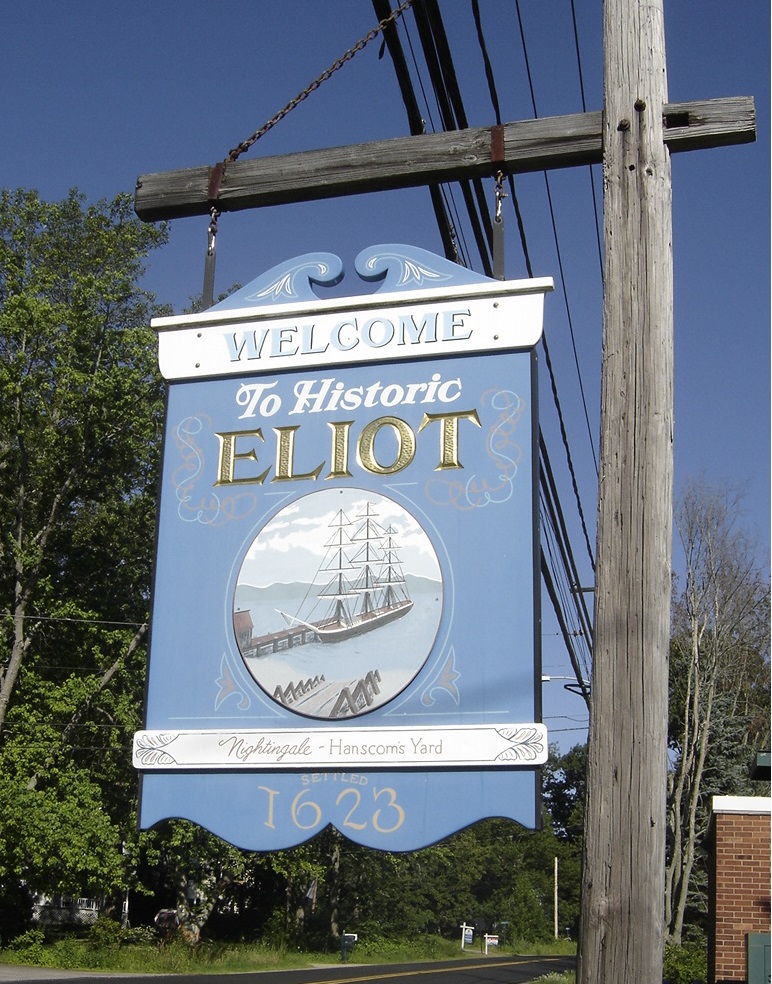 |
| Gorges Deed to Cammock |
Random investigations into the history of Eliot, Maine and the Piscataqua River region.
Tuesday, August 25, 2020
When was Eliot Settled?
Saturday, August 22, 2020
Who was Dennis Downing?
When researching Eliot's history one name that keeps coming up is "Dennis Downing". The main reason is his was one of the three names listed as victims of the Ambush Rock Indian attack in 1697. As the story goes, Major Charles Frost, Phebe Heard, wife of John Heard, and Dennis Downing were all struck down in that fateful ambush. But we also read of the immigrant Dennis Downing who settled on part of the land which became known as the Bay Lands in 1650. This immigrant Dennis Downing occupied about 30 acres of land which today makes up the Riverview development and Frost Tufts Park off the south side of Old Road. Were these two the same Dennis Downing? I will first see what I can find out about the earliest Dennis Downing who settled in the area of, what is today, Frost Tufts.
 |
| Location of Dennis Downing's homestead |
Various genealogy articles state that Dennis Downing lived in the "Spittlefields" section of London and married the widow Anne Daines in 1634. Dennis and Anne along with two sons, John and Joshua came to New England in 1650. His birth year is generally given as 1615 most likely to conform to his marriage date of 1634. So Dennis was about 35 when he came to settle in Kittery and worked his trade as a blacksmith. There are historical records that indicate that he had a residence at Crooked Lane in Kittery in addition to further up the river in what is now Eliot possibly due to his work as a blacksmith. Dennis Downing acquired the property at what is now Frost Tufts Park in December 1650 in a deed from George Smith of Dover, NH who was authorized by John Newgrove to sell his lands to Dennis who was already a tenant on his land. It is surmised that John Newgrove acquired this land from Henry Jocelyn who received the original grant of land that included all of the Bay Lands from his work on behalf of Captain John Mason. (See this link for more on the history of the Bay Lands.)
 |
| York Deeds Book 1 Folio 16 |
In 1652 Dennis Downing was one of the signers of the Submission to Massachusetts which placed Maine under the control of the Massachusetts Bay Colony.
 |
| Mark of Dennis Downing |
His estate was passed down to his son Joshua in 1676 (York Deeds Book 3 Folio 115) well before Dennis was dead. Eventually when the Bay Lands were sold in 1699 to Joseph Hammond, John Fogg, Matthew and David Libbey and Stephen Tobey, there would be a land boundary dispute between Joseph Hammond and Joshua Downing. A possible subject for a future post.
So is this Dennis Downing the same Dennis Downing that died at Ambush Rock in 1697? The evidence shows that Dennis Downing born about 1615 was alive in 1690, but by 1698 he was deceased.
 |
| York Deeds Book 4 Folio 151 |
The immigrant Dennis Downing would have been 82 years old when the Ambush Rock attack occurred. Major Charles Frost was 66 when he died in the same attack. Phebe Heard was 27. Would Dennis Downing at 82 years of age, have ridden on horseback from his homestead near the Piscataqua River to attend church services in the Unity Parish, modern day South Berwick? Another clue presents itself in the following:
| Old Eliot Vol 1 Page 84 |
Lyman Hammond's estate included most of the land in what today is the Eliot Boat Basin, or "Dead Duck Inn". This is nowhere near the homestead of the immigrant Dennis Downing. There is a mention of a 1694 land grant to a "Dennis Downing Jr." of 40 acres at "Beaver Dam":
 |
| Old Eliot Vol 4 Page 75 |
This would seem to imply that there was a younger Dennis Downing. Perhaps a son or grandson? I have not been able to link this land grant to the "estate of Mr. Lyman Hammond". More research is needed. I will update this post if new information comes to light.
Hammonds & Foggs of Old Road
View of Old Road from Fogg pasture 1910 Readers may remember my post about the Hammonds of Old Road from three years ago. In the last t...

-
I grew up in a small dairy farm town along the curve of the Connecticut River above the White Mountains in New Hampshire, called Monroe. It...
-
Old Road circa 1910 On a frigid Thursday morning on the last day of January in 1952, Edgar A. Hammond, a man who lived all of his life on hi...
-
1738 Frost Garrison When learning about Eliot history we hear a lot about "The Frost Garrisons". Not to be confused with "...






